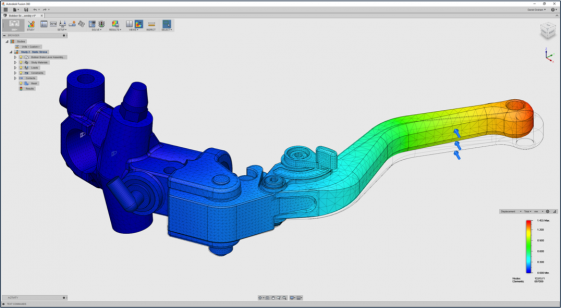New collaboration tools are not a free-for all, but eliminate lag time from review cycles by enabling review and comment in real time from any computer.
Autodesk continues meeting its almost-a-promise to deliver meaningful updates every six weeks to its hybrid cloud-client MCAD Fusion 360, this time with its first move into simulation and collaboration.
A new workspace called “SIM” is now live in Fusion 360, offering two kinds of simulation studies: Static Stress, and Modal Frequencies. Watch the video at the end of the article to see both in use. Static Stress can run single and/or multi-body static analysis. The user constrains an area, puts a load on it, and can then get results on how that load will affect the design. Modal Frequencies allows a view into the natural vibration frequencies of a design, to see how much deformation will occur at a specific frequency.

Study results from these simulations can be shared, viewed, and commented on by team members, using the Autodesk A360 collaboration portal.
Autodesk is calling the new collaboration features in Fusion 360 Live Review. Like the ability to share simulation results, Live Review uses A60, a web portal capable of 3D viewing. A designer can start a Live Review session with anyone, not just other subscribers to Fusion 360. Modeling edits made within Fusion 360 during a Live Review are visible in real time to anyone on the web session. It is not a free-for-all design scrum where anybody can change the model, but a way for one designer to show the current state of a design.
Product manager Kevin Schneider says conversations with customers convinced Autodesk they didn’t need to create a way for more than one person to change a model in real time. “Medical devices designers aren’t keen on having a doctor edit the file of a new surgery device; they just want his ideas and desires. This brings non-CAD experts into the design arena without everyone having editing rights.”
There are also incremental improvements in Fusion 360 to drawing, sketching, and rendering, and a new set of keyboard shortcuts.
What do we think?
Moving from the desktop to the cloud continues to rewrite the rules of CAD. With this update, Fusion 360 puts meaningful simulation into the hands of every designer, helping inform design early in the process. The advantage of the cloud is the availability of unlimited computation on demand to solve the simulation. The new collaboration capabilities takes advantage of cloud technology to remove asynchronous lag time from review cycles. Don’t send out screen grabs or 3D PDF files (or JT files or whatever viewing standard you use), organize a live review session.





